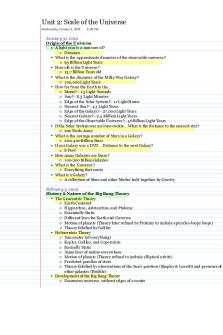Astron P1 - Expanding the Universe 2 PDF

| Title | Astron P1 - Expanding the Universe 2 |
|---|---|
| Author | Corey Johnston |
| Course | Introduction to Astronomy and Astrophysics |
| Institution | McMaster University |
| Pages | 2 |
| File Size | 163 KB |
| File Type | |
| Total Downloads | 458 |
| Total Views | 544 |
Summary
ASTRONOMY 1F03: The Expanding UniverseProcedure:1. Before the balloon is blown up, draw and number 10 “galaxies” on the balloon. Markone of these galaxies as the reference galaxy. Try to avoid drawing any too close to the neck of the balloon. 2. Blow up the balloon a little bit to the point where it...
Description
ASTRONOMY 1F03: The Expanding Universe Procedure: 1. Before the balloon is blown up, draw and number 10 “galaxies” on the balloon. Mark
2. 3.
4.
5. 6. 7. 8.
one of these galaxies as the reference galaxy. Try to avoid drawing any too close to the neck of the balloon. Blow up the balloon a little bit to the point where it is rounded. DO NOT TIE IT SHUT! Measure the distance between the reference galaxy and each of the numbered galaxies. The easiest way to do this is to use something flexible like the ruler printed on the bottom of this page. Record these data in the table. Be sure to indicate the units you are using. Now blow up the balloon. You can tie it shut this time if you like. 5. Measure the distance between the reference galaxy and each of the numbered galaxies. Record these data in the table. Subtract the first measurement from the second measurement, record the difference in the data table. Estimate the amount of time it took you to blow up the balloon (in seconds). Divide the distance traveled (the difference) by the time to get a velocity for each galaxy. In the space below plot the velocity, v versus the second measurement, d to get the "Hubble Law for Balloons". Don't forget to label your axes! Fit a line to your data on your plot. “Eyeballing” is close enough!
Galaxy Number
1st Measurement
2nd Measurement (d)
Difference
Velocity (v)
1 (reference)
0 cm
0 cm
0 cm
0
2
4.5 cm
7.5 cm
3 cm
3 / 4 = 0.75 m/s
3
5 cm
10.8 cm
5.8 cm
5.8/4 = 1.45 m/s
4
6 cm
14.5 cm
8.5 cm
8.5/4 = 2.13 m/s
5
9 cm
18.5 cm
9.5 cm
9.5/4 = 2.38 m/s
6
5.5 cm
14.6 cm
9.1 cm
9.1 / 4 = 2.28m/s
7
10 cm
16.7 cm
6.7 cm
6.7/4 = 1.68 m/s
8
8.5 cm
18.2 cm
9.7 cm
9.7/4 = 2.43 m/s
9
14 cm
29 cm
15 cm
15/4 = 3.75 m/s
10
12 cm
28.1 cm
16.1 cm
16.1 /4 =4.02m/s
9. Explain why the line must pass through (0,0) to be a model for the universe. - The line must pass through (0,0) because a reference point is needed to determine the distance between specified points. 10. Find the slope H₀ (v = H₀ d). This is exactly the way we find the value of H₀ from Hubble’s Law. - H₀ = v/d = 0.75/3 = 0.25 - Slope = 0.25 11. Find the age of your balloon universe from this slope. Think in terms of distance: d = vt. - t = d/v = d/(H₀ x d) = 3/ (0.25 x 3) = 4 billion years 12. What assumptions are you making by doing this? Are they sensible assumptions? - It is assumed that the universe has a fixed age. By observing the oldest stars, it’s sensible to assume that the estimations made about the universe are ture. 13. How would your results change if you used a different reference “galaxy” on the balloon? If you are not sure, try it! - The distances between the galaxies would change the velocity and the estimated age of the universe. The slope would also be different, and overall there would be a whole different outcome....
Similar Free PDFs

A Corner of the Universe
- 73 Pages

Astron notes - Google Docs
- 11 Pages

The Elegant Universe - Brian Green
- 190 Pages

Life in the Universe Notes
- 52 Pages

Tinbergen Universe
- 2 Pages

Internal Expanding Brake
- 23 Pages

Solucionario P1-2011-2
- 11 Pages

Simulado - Periodontia 2 - P1
- 5 Pages

P1
- 2 Pages

P1 L1 The Security Mindset
- 15 Pages

P1 L1 The Security Mindset
- 177 Pages

P1
- 28 Pages
Popular Institutions
- Tinajero National High School - Annex
- Politeknik Caltex Riau
- Yokohama City University
- SGT University
- University of Al-Qadisiyah
- Divine Word College of Vigan
- Techniek College Rotterdam
- Universidade de Santiago
- Universiti Teknologi MARA Cawangan Johor Kampus Pasir Gudang
- Poltekkes Kemenkes Yogyakarta
- Baguio City National High School
- Colegio san marcos
- preparatoria uno
- Centro de Bachillerato Tecnológico Industrial y de Servicios No. 107
- Dalian Maritime University
- Quang Trung Secondary School
- Colegio Tecnológico en Informática
- Corporación Regional de Educación Superior
- Grupo CEDVA
- Dar Al Uloom University
- Centro de Estudios Preuniversitarios de la Universidad Nacional de Ingeniería
- 上智大学
- Aakash International School, Nuna Majara
- San Felipe Neri Catholic School
- Kang Chiao International School - New Taipei City
- Misamis Occidental National High School
- Institución Educativa Escuela Normal Juan Ladrilleros
- Kolehiyo ng Pantukan
- Batanes State College
- Instituto Continental
- Sekolah Menengah Kejuruan Kesehatan Kaltara (Tarakan)
- Colegio de La Inmaculada Concepcion - Cebu



